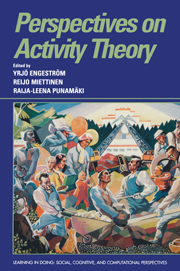Introduction
Published online by Cambridge University Press: 05 June 2012
Summary
Activity theory: A well-kept secret
Activity theory is a commonly accepted name for a line of theorizing and research initiated by the founders of the cultural-historical school of Russian psychology, L. S. Vygotsky, A. N. Leont'ev, and A. R. Luria, in the 1920s and 1930s. The approach has been elaborated further by a large number of contemporary scholars both in the former socialist countries and in the West. Although certain key works of Vygotsky and Luria are widely accessible and have become classic references in behavioral sciences (e.g., Vygotsky, 1978; Luria, 1976), the bulk of more recent activity-theoretical publications remain scattered and often difficult to obtain.
In the United States, very few books have been published that address the central theoretical concept of activity. These include Leont'ev's (1978) Activity, Consciousness, and Personality and two edited volumes of translated texts, The Concept of Activity in Soviet Psychology (Wertsch, 1981) and Activity: Theories, Methodology and Problems (Lektorsky, 1990). The first two have been out of print for quite a while. Moreover, all three books represent exclusively Soviet views.
Activity-theoretical ideas are having increased impact in specific fields of inquiry, such as learning and teaching (e.g., Moll, 1990) and human–computer interaction (e.g., Nardi, 1996). Activity theory is discussed in books attempting to formulate theories of practice (Chaiklin & Lave, 1993), distributed cognition (Salomon, 1993), and sociocultural psychology (Martin, Nelson, & Tobach, 1995).
- Type
- Chapter
- Information
- Perspectives on Activity Theory , pp. 1 - 16Publisher: Cambridge University PressPrint publication year: 1999
- 177
- Cited by



